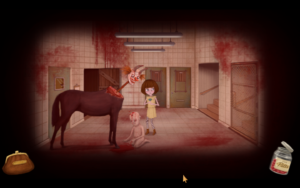Fran Bow
 The keynote at Narrascope was delivered by Natalia Martinsson, who described how her point-and-click adventure Fran Bow was inspired by her own experiences with trauma. Fran Bow has been installed on my laptop for some time, but I never seemed to be in the mood for it. It’s a troubling game, grotesque and gruesome. But now, I’ve been inspired to make a go of it. I’m currently in the middle of the second chapter of five.
The keynote at Narrascope was delivered by Natalia Martinsson, who described how her point-and-click adventure Fran Bow was inspired by her own experiences with trauma. Fran Bow has been installed on my laptop for some time, but I never seemed to be in the mood for it. It’s a troubling game, grotesque and gruesome. But now, I’ve been inspired to make a go of it. I’m currently in the middle of the second chapter of five.
Fran Bow is a severely traumatized ten-year-old girl in a stereotypically awful mental hospital, which she spends the first chapter of the game escaping, with the aid of some magical pills. She’s first given the pills in the intro sequence, but they give her nightmarish hallucinations, so her doctor immediately orders that she never be given them again. However, in the hallucination, she hears her beloved cat, Mr. Midnight, telling her to seek the pills out again, and so she does. The hallucinations essentially form an alternate reality, Silent Hill-style: it’s the same rooms, but there’s blood and dead animals all over the place, and shadowy monsters roam about. Sometimes Fran is strangely oblivious about this given that it’s her hallucination, referring to clearly dead creatures as “asleep” and the like. Other times, she is not. Her manner is a little Alice-in-Wonderland-ish, a mixture of childish whimsy and insistent precision, which makes me think a little of American McGee’s Alice, which similarly had grotesque loony bin scenes. But those were constructed entirely out of trope. Fran Bow‘s treatment of the same theme is more heartfelt, I think, although I can’t know what I would have thought without having heard the author speak on the matter.
You can toggle between the two worlds at will, and sometimes the nightmare world has hints for real-world puzzles, usually scrawled on the wall in blood. I suppose it’s sort of shamanic, the use of hallucinogens to access the spirit realms and learn secrets of importance. In this realm, other patients at the hospital tend to have black shadow-creatures holding them, presumably manifestations of their mental illness. A couple of times, I’ve heard people say things like “You can see them, can’t you?”. The pills are, at the very least, enhancing your perceptions, showing you things that are in some sense objectively real. But more than that: there are puzzles based on bringing objects from the spirit world back to the real world with you. In the second chapter, the lines get blurred even more: there’s a couple of monstrous insects that really belong in the spirit world, but which you encounter in the real world. Maybe none of the adventure is real. Maybe Fran is still in her room in the hospital, tripping throughout.
At a different panel at Narrascope, it was pointed out how Black Mirror: Bandersnatch had a possible sub-plot about the main character going off his meds in order to regain control of himself. The consensus among the panelists was that this was a terrible lesson to teach people about psychiatric medications. Fran Bow leans in the opposite direction, but it’s still kind of the same: Fran doesn’t trust her doctor — in fact, she pretty much hates him — and so she enthusiastically takes pills that he doesn’t want her to have, and they turn out to be vitally important to her progress through the game, which I’m at the moment assuming is positive for her psychological recovery and growth. If “Go off your meds” is a bad message, surely “Take meds your doctor specifically forbids” is even worse? But I suppose it’s saved by its unrealism, as well as the sheer unpleasantness of Fran’s otherworld. Doing what Fran does outside of a game is such a clearly and obviously bad idea as to deter imitation in itself. At least, I hope so.
 Comments(0)
Comments(0)